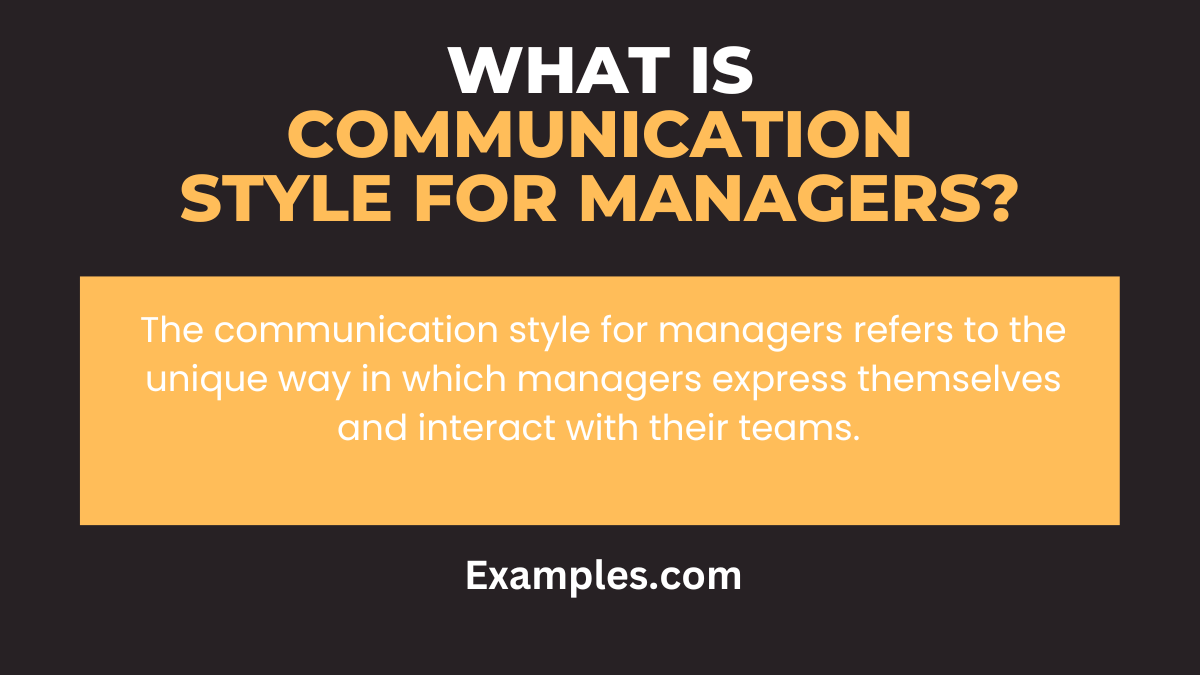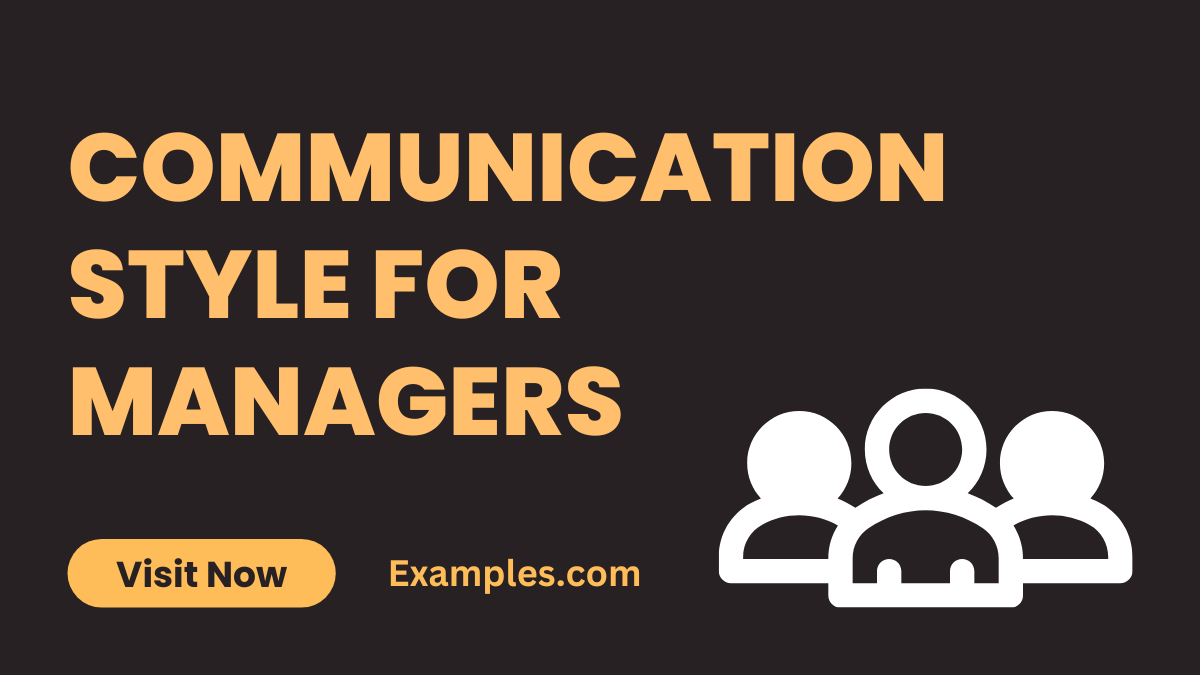9+ Communication Style for Managers
comprehensive guide on Communication Style for Managers. Dive into insightful examples that illuminate the diverse strategies employed by successful managers. From fostering team collaboration to navigating challenging situations, this guide provides a nuanced understanding of communication styles and their real-world applications. Elevate your managerial skills with practical insights and actionable examples, ensuring you master the art of impactful communication in diverse professional scenarios.
Download Communication Style for Managers in PDFWhat is Communication Style for Managers?

The communication style for managers refers to the unique way in which managers express themselves and interact with their teams. It encompasses the tone, approach, and methods used by managers to convey information, provide guidance, and foster collaboration. A manager’s communication style significantly influences team dynamics, work culture, and overall organizational success. It involves adapting to various situations, understanding team members’ preferences, and effectively conveying messages to ensure clarity and alignment with organizational goals.
10 Examples Of Communication Style for Managers

Exploring various communication styles for managers unveils a spectrum of approaches crucial for effective leadership. From authoritative to collaborative styles, understanding their nuances is key to fostering productive work environments and cohesive teams.
- Authoritative Style: Managers exert control, potentially stifling creativity. To fix, encourage team input in decision-making while maintaining authority.
- Collaborative Approach: Encourages teamwork but may prolong decisions. Fix by setting clear timelines and responsibilities while fostering collaboration.
- Directive Style: Offers clarity but limits autonomy. Balance by providing guidance while allowing flexibility in execution.
- Democratic Style: Fosters team participation but can lead to decision delays. Fix by establishing efficient decision-making protocols.
- Visionary Style: Inspires but might overlook practical details. Bridge by outlining actionable steps within the visionary framework.
- Pacesetting Technique: Drives high standards but may stress teams. Address by balancing expectations and supporting skill development.
- Transformational Method: Motivates but might lack specificity. Augment by aligning inspirational messaging with practical goals.
- Coaching Approach: Develops individuals but could ignore broader team needs. Address by balancing individual growth with team objectives.
- Affiliative Style: Builds trust but might overlook performance issues. Rectify by balancing emotional support with constructive feedback.
- Democratic Technique: Encourages participation but might prolong decision-making. Resolve by setting clear agendas and deadlines for discussions.
Examples Of Communication Style for Managers at a Company
Navigating communication styles as a manager is pivotal for team synergy. Understanding communication styles in relationships and communication styles in the workplace facilitates effective leadership. Tailoring your approach ensures clear directives, fosters collaboration, and builds a conducive work environment.
- Strategic Communicator: Aligns communication with company goals, fostering a unified vision. In team meetings, the strategic communicator links tasks to overarching company objectives.
- Adaptive Leader: Tailors communication to diverse teams, ensuring inclusivity. When addressing cross-functional groups, the adaptive leader adjusts language and tone to resonate with various departments.
- Results-Driven Manager: Prioritizes outcome-oriented communication to drive performance. In project updates, they focus on achievements and future milestones, instilling a results-driven mindset.
- Crisis Communicator: Effectively handles challenges, providing reassurance and guidance. During crises, this communicator maintains transparency, addressing concerns and outlining the company’s action plan.
- Innovative Facilitator: Encourages creative discussions and embraces novel ideas. In brainstorming sessions, the innovative facilitator fosters an environment where employees feel empowered to share inventive solutions.
- Proactive Informer: Anticipates information needs, ensuring timely updates. In company-wide communications, the proactive informer shares relevant updates, pre-empting potential questions or concerns.
- Transparent Leader: Cultivates openness, sharing both successes and challenges. During company meetings, the transparent leader provides candid insights, building trust and understanding among employees.
- Collaborative Orchestrator: Fosters teamwork and collective problem-solving. In project planning, this communicator ensures all team members contribute ideas, fostering a collaborative atmosphere.
- Ethical Communicator: Upholds company values in all communications, setting an example. When addressing ethical considerations, the ethical communicator reinforces the company’s commitment to integrity and responsible conduct.
- Inclusive Messenger: Prioritizes inclusivity, ensuring all voices are heard. In decision-making, the inclusive messenger seeks input from diverse perspectives, promoting a culture of equality.
Examples Of Coaching Communication Style for Managers
This coaching communication style for managers fosters a culture of mentorship, guiding individuals toward success while aligning with communication styles for students and communication styles for leaders.
- Developmental Mentor: Focuses on individual growth, identifying and nurturing talents. In performance reviews, the developmental mentor outlines personalized development plans for each team member.
- Feedback Facilitator: Emphasizes constructive feedback to spur continuous improvement. Regularly, the feedback facilitator provides specific, actionable feedback to help employees refine their skills.
- Goal-oriented Coach: Aligns individual goals with company objectives for mutual success. In one-on-one sessions, the goal-oriented coach collaborates with employees to set SMART goals that contribute to the company’s vision.
- Skill-building Advisor: Prioritizes enhancing specific skills to boost overall performance. Identifying gaps, the skill-building advisor tailors training and development opportunities for employees.
- Motivational Guide: Inspires and uplifts, promoting a positive and supportive atmosphere. During challenging projects, the motivational guide encourages employees, highlighting their strengths and accomplishments.
- Communication Specialist: Focuses on enhancing verbal and written communication skills. The communication specialist provides targeted coaching to improve clarity, conciseness, and effectiveness in communication.
- Balance Advocate: Nurtures a work-life balance to ensure sustained productivity. In coaching sessions, the balance advocate discusses time management and stress reduction strategies to promote well-being.
- Goal-setting Partner: Collaboratively establishes and monitors individual career objectives. The goal-setting partner engages in ongoing discussions about career aspirations, assisting employees in navigating their professional journey.
- Strengths Harnesser: Identifies and leverages employees’ strengths for optimal results. In project assignments, the strengths harnesser aligns tasks with individuals’ strengths, maximizing performance and job satisfaction.
- Continuous Learner’s Companion: Encourages a mindset of lifelong learning and development. The continuous learner’s companion recommends relevant courses, workshops, and resources to support ongoing professional growth.
What are the Effective Communication Styles for Managers?
Understanding effective communication styles is pivotal for managerial success. Managers adopt various approaches, such as casual communication and communication style for influencers, to engage teams effectively and navigate diverse workplace scenarios.
- Authoritative Communication Style: In situations requiring clear direction, an authoritative style is effective. Managers assert control, providing clear instructions and making decisive decisions.
- Collaborative Communication Approach: Encouraging team participation and shared decision-making defines the collaborative style. Managers create an inclusive environment, valuing input from team members.
- Visionary Communication Technique: Managers employing a visionary style inspire teams with a compelling vision. They communicate a sense of purpose, motivating individuals to align their efforts with long-term goals.
- Adaptive Communication Method: Adaptability is crucial for managers. Those with an adaptive style tailor their communication to suit different team members and situations, fostering inclusivity.
- Strategic Communication Model: Strategic communicators align their messages with overarching company goals. They connect tasks to the bigger picture, ensuring everyone comprehends their role in achieving objectives.
- Transparent Communication Practice: Transparency builds trust. Managers utilizing a transparent style openly share information, both positive and challenging, promoting a culture of openness within the team.
- Coaching Communication Style: A coaching approach involves guiding individual growth. Managers act as mentors, providing constructive feedback, encouragement, and tailored guidance for employee development.
- Results-Driven Communication Technique: Managers adopting a results-driven style prioritize outcomes. They focus on achieving goals, emphasizing measurable results to drive team performance.
How to Communicate with Different Communication Styles
Effective communication with diverse styles is a hallmark of successful managerial leadership. Navigating various communication preferences within a team fosters understanding, collaboration, and a positive work environment. Here’s a comprehensive guide on tailoring your communication approach to resonate with different styles:
- Understand Individual Styles: Begin by identifying the predominant communication styles among team members. Recognize variations in assertiveness, responsiveness, and preferred channels.
- Adapt Your Language: Tailor your language to match the preferences of each team member. Adjust your tone, level of detail, and formality based on their communication style.
- Listen Actively: Effective communication involves active listening. Pay attention to verbal cues, body language, and the overall tone to grasp the nuances of each individual’s communication style.
- Adjust Your Pace: Some team members may prefer a rapid exchange of ideas, while others may require more time for contemplation. Adapt your communication pace to accommodate different preferences.
- Use Varied Communication Channels: Recognize that individuals have preferences for specific communication channels—some may prefer emails, while others favor face-to-face interactions. Utilize a mix of channels to cater to diverse styles.
What Are The Different Communication Styles for Managers
Managers employ diverse styles: authoritative, collaborative, visionary, and more. Adapting to team dynamics ensures effective leadership, fostering positive work environments and cohesive teams.
How TO Identify Passive Communication Style
Passive communicators avoid expressing needs or concerns. Spot subtle cues like hesitancy, avoidance of eye contact, and reluctance to share opinions. Address by encouraging open dialogue and feedback.
Identify Assertive Communication Styles
Assertive communicators express thoughts clearly, respecting others. Recognize assertiveness through confident tone, clear expression, and respectful behavior. Foster assertive communication to promote open dialogue and collaborative problem-solving in the workplace.
In conclusion, mastering effective communication styles is pivotal for managerial success. Nurturing a diverse range of styles enhances leadership impact, fostering collaborative environments. Explore further insights into communication styles for students and communication styles for leaders to broaden your understanding and refine your leadership approach. Elevate your communication skills for impactful and harmonious leadership.



